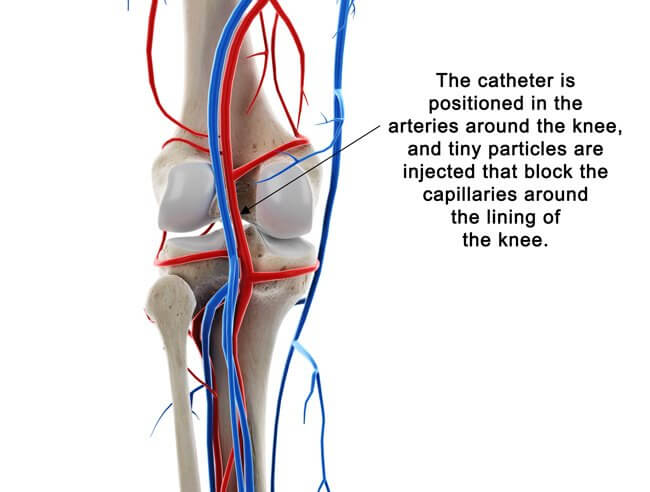Knee pain caused by osteoarthritis can be debilitating. For many people, it interferes with daily activities, sleep, and quality of life. While knee replacement surgery is a common solution, not everyone is ready—or eligible—for knee surgery. Fortunately, exciting medical innovation has led to a non-surgical, minimally-invasive outpatient procedure called Genicular Artery Embolization (GAE) that is transforming the way chronic knee pain is treated for both men and women.
In this guide, we’ll break down how GAE works, why it’s effective for knee osteoarthritis, what to expect during the procedure, recovery time, and whether it might be the right option for you.

Genicular Artery Embolization, also known as geniculate artery embolization, is a minimally-invasive procedure used to reduce chronic knee pain, especially in patients suffering from osteoarthritis (OA). It targets small arteries surrounding the knee, known as genicular arteries, which supply blood to inflamed tissues.
When the genicular arteries are overactive, they contribute to ongoing inflammation in the knee joint. GAE works by blocking or “embolizing” these arteries, which decreases blood flow to the area and helps reduce inflammation and pain.
Unlike traditional surgery, GAE is performed without incisions inside the joint. Instead, it uses a small catheter inserted through a blood vessel in the leg or wrist, guided by advanced imaging.
In patients with knee osteoarthritis, the joint becomes inflamed due to the breakdown of cartilage and the release of inflammatory signals. The genicular arteries respond by increasing blood flow to the area, which worsens inflammation.
GAE targets this process at the vascular level. By selectively blocking the arteries feeding inflamed tissues:
The procedure does not repair cartilage or replace bone, but it does interrupt the cycle of inflammation and pain, offering relief for many months or even years.

You may be a good candidate for GAE if:
GAE is especially suitable for patients with mild to moderate osteoarthritis who are seeking a non-operative treatment.
It’s not typically recommended for patients with severe, bone-on-bone arthritis or joint instability where surgical intervention is unavoidable.
Please schedule a visit with our experts to learn if you’re a good candidate for this life-changing procedure.
The GAE procedure is outpatient and typically takes 1–2 hours. Here’s what to expect:
You’ll lie comfortably on a procedure table. The doctor will numb the area around your groin or wrist where the catheter will be inserted. Sedation is usually light—you’ll be awake but relaxed.
A tiny catheter is inserted through a small puncture into a major artery, such as the femoral artery. Using real-time X-ray imaging, the doctor guides the catheter to the genicular arteries in the knee.
Once in position, microscopic particles are injected through the catheter to block blood flow in the overactive arteries. These particles are safe and biocompatible.
The catheter is removed, and pressure is applied to stop any bleeding. A small bandage is placed over the access site—no stitches are needed.
One of the biggest advantages of GAE is its quick recovery time.
Immediately after the procedure:
In the following weeks:
GAE offers several compelling advantages for patients seeking relief from knee osteoarthritis without surgery:
Patients also appreciate that GAE avoids the risks associated with general anesthesia and surgical complications.
While GAE is considered safe and effective, as with any medical procedure, there are potential risks. These include:
At Preferred Vascular Group, our team uses the latest imaging technology and advanced techniques to ensure patient safety and successful outcomes.
Clinical studies have shown impressive results:
While it doesn’t reverse osteoarthritis, it significantly reduces the pain associated with inflammation—offering a higher quality of life for many patients.
Knee replacement is an effective option for advanced arthritis, but it involves:
GAE offers a simpler path for patients who:
For many, GAE is a bridge treatment that can delay the need for surgery or provide long-term relief without going under the knife.
If you’re suffering from chronic knee pain due to osteoarthritis and haven’t found relief with standard therapies, GAE may be worth considering. It’s safe, effective, and provides a meaningful alternative to joint replacement surgery.
At Preferred Vascular Group, our interventional specialists are experts in Genicular Artery Embolization and other non-surgical vascular treatments. We’ll evaluate your condition and recommend the best personalized solution for your needs.
Don’t let knee pain limit your life. Learn how Genicular Artery Embolization can help you move freely again—without surgery.
Contact Preferred Vascular Group today with any questions you may have on the revolutionary GAE procedure.
Book an Appointment Now to schedule your consultation and discover if GAE is right for you.
See all our locations in Georgia and Ohio to find the office closest to you for your needs.
We look forward to serving you!